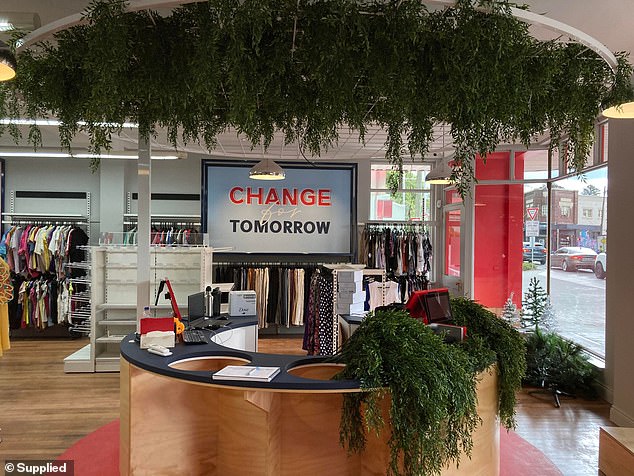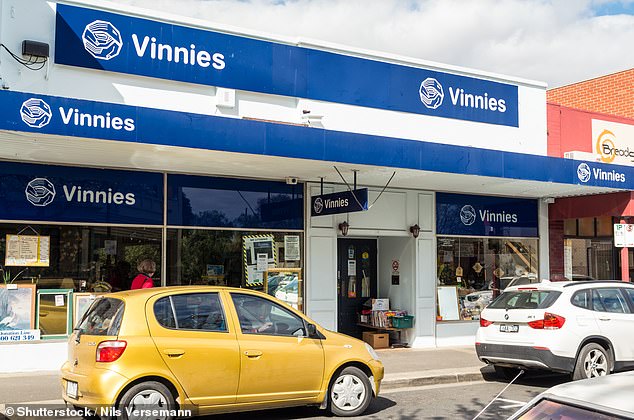It’s a growing frustration voiced by struggling Aussies – they visit an op-shop hoping to snag a bargain, only to be hit with prices as high as those found in traditional retail stores.
And an expert in the not-for-profit sector has now lifted the lid on why cheap op-shop items – from clothing to furniture – seem to be a thing of the past.
Dr Bronwen Dalton said the main factors were the cost-of-living and property crises, which have driven up rent.
‘We used to do (this thing) where councils had ‘peppercorn’ rents (low or nominal rents) for op-shops, so much reduced rents,’ she told Daily Mail Australia.
‘That’s slowly disappeared… local councils just don’t offer cheap rent anymore.’
The other ‘big impact’ has been the cost of dealing with garbage.
‘You find less and less donation bins because if they’re not emptied regularly – like in the east (of Sydney) – it becomes insane the amount of garbage that gets dumped,’ she said.
Although thrifting has gained popularity as a rejection of fast fashion, the rise of cheap online retailers is also making business more difficult for op-shops.

Op-shops have come under fire for higher prices, but an expert says they are suffering from the housing and cost-of-living crisis much like consumers (above, a Vinnies store)
‘Because of fast fashion like Shein, massive amounts of really, really poor-quality clothing that is not fit for sale is dumped, and (charities) have to cover the costs of getting rid of it,’ Dr Dalton said.
She said the housing crisis has also fuelled dumping of bigger items which cost charities thousands of dollars to get rid of.
‘Charities are used as a way to get rid of stuff, people just don’t want it and don’t particularly care what happens to it,’ she said.
‘I know young people are having to move a lot, they keep on turning flats into Airbnbs, or making up some excuse that’s just a ruse to raise the rent on people, so people are having to move around a lot in a housing crisis.
‘We get a big increase in winter, and people have to move a lot and flats are getting smaller, so they’re dumping it near the charity bins.’
Councils have a ‘big role to play’ in addressing the situation for both charity stores and the people who rely on them, she said.
‘That is really what I think – there’s a big role for councils and also for the managers of shopping malls, because there is a lot of unused retail space.’
On the other hand, Dr Dalton also suggested charities move to a ‘less commercial’ ethos.

Dr Bronwen Dalton AO said fast fashion dumping was costing charities who have to dispose of the goods
Partially, overheads have risen as charities look to ‘professionalise’ and run their operations in a more ‘business-minded’ fashion.
They are looking to create branding opportunities and rely less on volunteers as they gain in popularity.
‘Some of the charities have tried to really rebrand – Vinnies invested quite a bit, you know, it’s got a kind of an identity, and it’s (selling) new things as well as the donated stuff,’ she said.
‘There’s been a bit of, “charities are badly run; we should get CEOs from business because they really know how to run things”.
‘CEOs from the business sector bring their ideas which don’t take into account the mission and community.’
Dr Dalton said Vinnies has revitalised the business-side of operations, but hasn’t necessarily helped consumers.
Vinnies commercial enterprise executive director Phil Coyte has a 25-year history with the society, and said second-hand resellers forced charities to change tack.
‘Given the rising global awareness around waste in fashion, there is a renewed movement towards pre-loved and slow fashion, he said.

However, Dr Dalton said charities have increasingly sourced leaders from the private sector to commercialise their stores (above, Salvos’ ‘O by Salvos’ in Bondi Junction)

The expert said people also expected clothes at a cheaper price point, as their other expenses increase (above, Vinnies at Mont Albert, Victoria)
‘On the back of this, the for-profit, second-hand market has entered the op shop market at scale and changed the game.
‘Not-for-profits, like Vinnies, have had to evolve our approach and model to remain relevant and appeal to the changing competitive market. Branding is critical to this and it’s important to build our presence amongst for-profit retailers and online resellers.’
Consumers too have developed an expectation of cheaper clothes, based in part on cheap overseas imports and Australians’ diminished purchasing power as other expenditures rise.
‘Clothing, to be honest, as a percentage of people’s budgets, has really been dwarfed by rent in particular. So people expect clothes to be cheaper as well,’ Dr Dalton said.
‘That said, I think there’s a huge thrift refashioning. The millennials are really embracing the circular economy and rejecting fast fashion.
‘I know my daughter’s always in shops redoing things with her friends, which is really cool. If we just get that sweet spot right – there’s definitely a market.’
Mr Coyte said, despite consumers’ hypotheses, Vinnies’ own vision had not changed.
‘The intent of our Vinnies Shops has not changed since (members) started operating op-shops over 100 years ago,’ he said.
‘An original driver for the development of Vinnies shops was the provision of a pipeline of stock that could be given for free to those who needed direct material assistance.’
Vinnies NSW supported close to 105,000 people and dependents in the last financial year.
